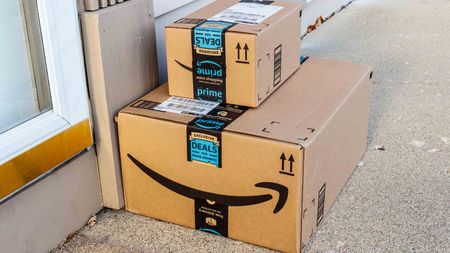Best Deals on Student Loans
The feds will lend you all the money you need for an Ivy League education.

The letters drift in all spring, bringing joy and disappointment to high school seniors anxiously awaiting a verdict on their college dreams.
Admissions letters? Actually, we're referring to financial-aid award letters, which spell out how much of the college bills each school (and the government) is prepared to cover. For some students, the letters bring glad tidings of scholarships, which don't have to be paid back. Others get an invitation to borrow -- and most RSVP yes. The average student debt over four years comes to almost $20,000, a figure that doesn't include money parents owe. "We have no qualms about borrowing," says Robert Bray, whose son, Matthew, took out loans to help finance his freshman year at the University of California at Santa Cruz. "It's an investment in his future."
| Row 0 - Cell 0 | Ways to Borrow Less |
| Row 1 - Cell 0 | Everything You Need to Know About College Aid |
| Row 2 - Cell 0 | More Help With College Costs |
| Row 3 - Cell 0 | Smart Ways to Pay for College |
| Row 4 - Cell 0 | How To Maximize College Aid |
Fair enough, but figuring out which loans to get, and where, can feel like taking an Advanced Placement test for a class you've never attended. Complicating matters, the New York State Attorney General's Office has turned up irregularities in the way some financial-aid offices put together their "preferred lender" lists -- the companies that schools recommend when they send out their financial-aid letters.

Sign up for Kiplinger’s Free E-Newsletters
Profit and prosper with the best of expert advice on investing, taxes, retirement, personal finance and more - straight to your e-mail.
Profit and prosper with the best of expert advice - straight to your e-mail.
Although most financial-aid offices operate in good faith, the controversy is a reminder to do your own homework.
Where to start
Luckily, the best strategy is also the most straightforward. "Go with federal loans first," says Robert Shireman, executive director of the Project on Student Debt. Not only do new federal loans carry a fixed interest rate, but they also are easy to apply for, and offer flexible repayment terms and, in some cases, a government subsidy for part of the interest.
As with other loans that are used for higher education, you can deduct interest payments of up to $2,500 per year. The deduction disappears for married couples who are filing jointly and have an adjusted gross income of $135,000 and for singles with an adjusted gross income of $65,000.
Grab a Perkins. First among equals in the federal-loan lineup is the Perkins, which offers students up to $4,000 a year at a fixed 5%. The feds pick up the tab on the interest until the loan comes due. Students can defer repayment for nine months after leaving school and spread the payments over ten years. Graduates who work as teachers or social workers in low-income neighborhoods or who fill other needed jobs may qualify for loan forgiveness.
You don't have to shop for a lender to connect with a Perkins. Schools distribute the dollars themselves. These days, they dole them out sparingly.
The federal fund that supplies the loans "isn't being replenished to the full amount," says Justin Draeger, of the National Association of Student Financial Aid Administrators. Students who are lucky enough to be offered a Perkins loan should waste no time accepting it.
Secure a Stafford. After the Perkins, "the Stafford is the loan you want to go with," says Gary Carpenter, a certified college planner in Syracuse, N.Y. Available to any student who applies for federal financial aid, it carries a fixed rate of 6.8% -- not bad, compared with the recent prime rate of 8.25%. (Stafford loans disbursed before July 2006 have a variable rate, which adjusts each July based on the 91-day Treasury bill at the end of May.) Students may borrow up to $3,500 a year as freshmen, $4,500 as sophomores, and $5,500 as juniors and seniors.
If your family qualifies for need-based aid, the federal government will pay the interest on the Stafford until the loan comes due. Otherwise, interest starts building on day one. Students can defer repayment until six months after graduation and extend repayment from the standard ten years to as many as 25, lowering the monthly amount (but adding to the overall cost of the loan).
Uncle Sam makes for a lenient lender, as long as you don't duck out on your obligation altogether. Borrowers who ask for forbearance can postpone payments for up to a year at a time and defer them if they return to school.
As with Perkins loans, Staffords can be forgiven under some circumstances.
Add a PLUS. But even a Stafford and a Perkins combined won't get your kid through a whole year at a private university, where the average annual cost runs about $30,000. To cover the gap, look to a PLUS loan (Parent Loan for Undergraduate Students), the parent's equivalent of a Stafford. PLUS-loan interest is fixed at 8.5% (the rate on PLUS loans issued before July 2006 remains variable, capped at 9%).
You must pass a basic credit check to get this deal. Once approved, you can borrow up to the total cost of attendance, minus any financial aid. Although the standard PLUS loan requires you to start repaying within 60 days of disbursement, some lenders allow you to defer repayment until your child has left school.As of July 2006, grad students can also apply for PLUS loans. That's great news for students who would otherwise load up on private loans, which carry variable rates and tougher terms.
Find a lender. Where do you get these generous deals? Schools that participate in the Federal Direct Loan Program give you direct access to Uncle Sam's largesse; the government funds the loans, and the school administers them.
[page break]
The majority of schools, however, leave it to you to choose a lender, and that's where the process gets tricky. Commercial lenders vie for your business by offering to waive processing fees, pare the fixed rate and bestow rebates on borrowers who pay electronically or on time for, say, 24 or 36 consecutive months. Comparing those sweeteners can drive you crazy, says Thom Hunzicker, a college financial planner in San Dimas, Cal. "It's hard to research this stuff. There should be a way to quantify the moving parts."
Over the years, financial-aid offices have tried to do just that by vetting deals and sending families a list of preferred lenders. Recently, some financial-aid officers have been accused of accepting their own sweeteners, such as stock options and trips, from lenders who appeared on the lists. Other institutions have acknowledged taking money from lenders in exchange for sending borrowers their way.
Such back-scratching may have blemished the integrity of the lists, but you should still start there, says Keith Landis, of Collegiate Advisors, which provides technical backup to college financial planners. Colleges have more clout than the average 18-year-old. "In most cases, the price the student gets through the preferred-lender list is still better than what the student would get directly from the lender," says Landis.
Cover your bases by checking a few other programs (you can find a list of lenders and their discounts at www.finaid.org). Investigate nonprofit lending agencies in both your state and the state where your child will attend school. Such agencies use low-cost loans to encourage students to study -- and stay -- within state borders. For instance, the College Foundation of North Carolina offers a dirt-cheap 4.3% interest rate on Staffords (after discounts) to state residents, out-of-state students attending college in North Carolina and families who contribute to the state's 529 savings plan.
Wherever you shop, look for up-front benefits, such as an interest-rate reduction at the start of repayment, rather than future perks -- say, for making 36 on-time payments. "That's like saying, if I make the 260th through the 290th payment on my mortgage on time, I'll get a discount. No one ever does that," says Landis. Keep in mind, too, that many students consolidate their loans early in repayment, rendering future discounts meaningless.
Dip into home equity
If you're a homeowner, you've probably already considered using home equity to cover some of the college bills. Borrowing against home equity makes sense if you earn too much to qualify for the student-loan interest deduction. You can deduct interest on up to $100,000 of home-equity loans.
Some college financial planners recommend going with a home-equity line of credit, which lets you borrow money as you need it, rather than taking a second mortgage and paying interest on the whole amount. But the line of credit's variable rate, currently at almost 9%, puts you at risk, says Hunzicker. "Who knows what will happen with interest rates?" He prefers second mortgages with fixed rates, lately about 8.2%.
One more consideration: A home- equity line of credit can enhance your chances for financial aid, whereas a second mortgage can hurt them, depending on whether the school counts home equity as an asset. Before you jump into one or the other, find out how the school determines financial need.
Protect retirement
You deserve a scolding for even thinking of borrowing against your 401(k) retirement account. "All you're doing is postponing the problem," says Carpenter. "You may be signing on for another five years of work because you don't have enough money to retire."
You're required to pay back a 401(k) loan within five years. But if you leave your job, you must repay it immediately or owe taxes on the amount, plus a 10% penalty.
In a pinch, go private
Given all the other choices, you'd think students could avoid resorting to private loans. Not so. Private loans have become the fastest-growing sector of the student-loan industry, totaling $16 billion in 2005-06. Undergraduates who use private loans borrow an average of $6,000 a year, and graduate students dig themselves in to the tune of more than $8,000.
Private-loan interest rates, which are variable, depend on the prime rate or LIBOR benchmark as well as the borrower's credit rating. The best deals, according to FinAid, carry an interest rate of LIBOR plus 1.8%, or prime minus 1%, with no fees. But only about 20% of borrowers get the lowest rates, says Kevin Walker, of SimpleTuition (www.simpletuition.com), which compares private loans. Borrowers with poor credit can expect to pay up to six percentage points more than the advertised rate, according to FinAid, and fees that are significantly higher.
You can't know the rate you'll be charged without actually applying. Shireman, of the Project on Student Debt, recently tested the market by applying for several private loans, using comparison sites such as SimpleTuition. Despite a top credit score, he ended up with offers ranging from 7.9% with no fees to almost 10% plus 4% in fees. No offer matched the teaser rate.
Bottom line? Max out the federal options, then shop for private loans that track federal loans as closely as possible, including those that let you defer or extend repayment, says Draeger. State agencies, such as the College Foundation of North Carolina, offer private as well as federal loans. Check them out first.
Get Kiplinger Today newsletter — free
Profit and prosper with the best of Kiplinger's advice on investing, taxes, retirement, personal finance and much more. Delivered daily. Enter your email in the box and click Sign Me Up.

-
 Stock Market Today: Dow Rises 854 Points From Its Intraday Low
Stock Market Today: Dow Rises 854 Points From Its Intraday LowIf there's one thing markets hate, it's uncertainty. But uncertainty is all they're getting these days.
By David Dittman Published
-
 Are You a Retirement Millionaire Too Scared To Spend?
Are You a Retirement Millionaire Too Scared To Spend?If you are too scared to spend money in retirement, you may be saddled with regret. Here are three ways to safely enjoy your sizable retirement nest egg.
By Donna Fuscaldo Published
-
 Roth IRA Contribution Limits for 2025
Roth IRA Contribution Limits for 2025Roth IRAs Roth IRA contribution limits have gone up. Here's what you need to know.
By Jackie Stewart Last updated
-
 Four Tips for Renting Out Your Home on Airbnb
Four Tips for Renting Out Your Home on Airbnbreal estate Here's what you should know before listing your home on Airbnb.
By Miriam Cross Published
-
 Five Ways to a Cheap Last-Minute Vacation
Five Ways to a Cheap Last-Minute VacationTravel It is possible to pull off a cheap last-minute vacation. Here are some tips to make it happen.
By Vaishali Varu Last updated
-
 How to Figure Out How Much Life Insurance You Need
How to Figure Out How Much Life Insurance You Needinsurance Instead of relying on rules of thumb, you’re better off taking a systematic approach to figuring your life insurance needs.
By Kimberly Lankford Last updated
-
 Amazon Big Deal Days Is Coming! We’ve Got All the Details
Amazon Big Deal Days Is Coming! We’ve Got All the DetailsAmazon Prime To kick off the holiday season with a bang, Amazon Big Deal Days runs Tuesday, October 8 and Wednesday, October 9.
By Bob Niedt Last updated
-
 How to Shop for Life Insurance in 3 Easy Steps
How to Shop for Life Insurance in 3 Easy Stepsinsurance Shopping for life insurance? You may be able to estimate how much you need online, but that's just the start of your search.
By Kaitlin Pitsker Last updated
-
 Five Ways to Shop for a Low Mortgage Rate
Five Ways to Shop for a Low Mortgage RateBecoming a Homeowner Mortgage rates are high this year, but you can still find an affordable loan with these tips.
By Daniel Bortz Last updated
-
 Retirees, It's Not Too Late to Buy Life Insurance
Retirees, It's Not Too Late to Buy Life Insurancelife insurance Improvements in underwriting have made it easier to qualify for life insurance, which can be a useful estate-planning tool.
By David Rodeck Published